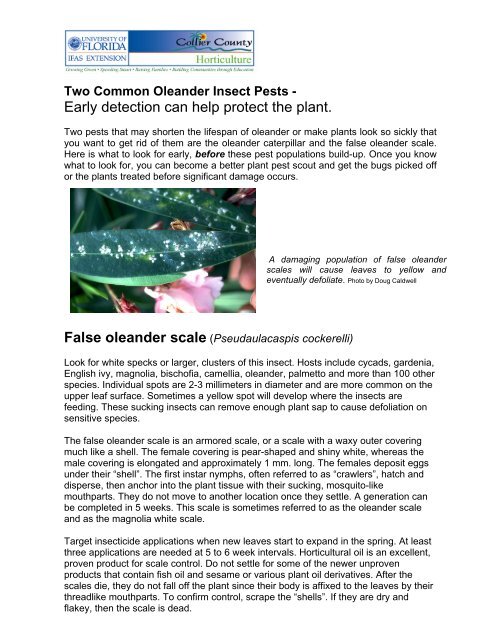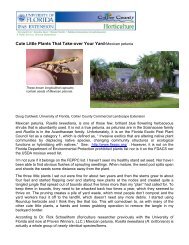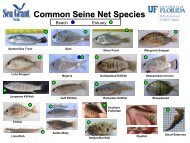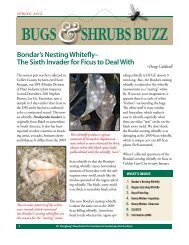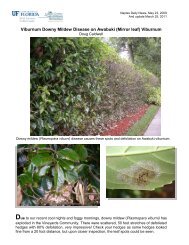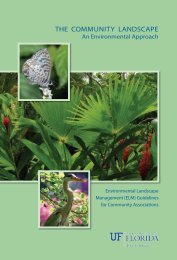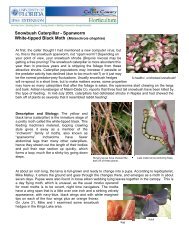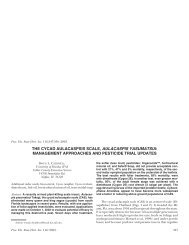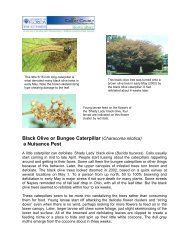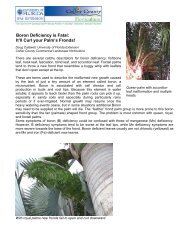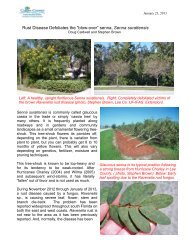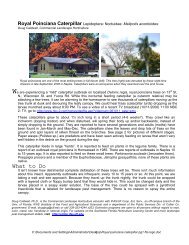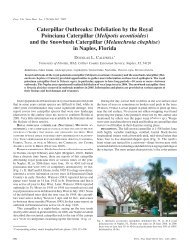Two Common Oleander Insect Pests - Collier County Extension ...
Two Common Oleander Insect Pests - Collier County Extension ...
Two Common Oleander Insect Pests - Collier County Extension ...
You also want an ePaper? Increase the reach of your titles
YUMPU automatically turns print PDFs into web optimized ePapers that Google loves.
<strong>Two</strong> <strong>Common</strong> <strong>Oleander</strong> <strong>Insect</strong> <strong>Pests</strong> -<br />
Early detection can help protect the plant.<br />
<strong>Two</strong> pests that may shorten the lifespan of oleander or make plants look so sickly that<br />
you want to get rid of them are the oleander caterpillar and the false oleander scale.<br />
Here is what to look for early, before these pest populations build-up. Once you know<br />
what to look for, you can become a better plant pest scout and get the bugs picked off<br />
or the plants treated before significant damage occurs.<br />
False oleander scale (Pseudaulacaspis cockerelli)<br />
A damaging population of false oleander<br />
scales will cause leaves to yellow and<br />
eventually defoliate. Photo by Doug Caldwell<br />
Look for white specks or larger, clusters of this insect. Hosts include cycads, gardenia,<br />
English ivy, magnolia, bischofia, camellia, oleander, palmetto and more than 100 other<br />
species. Individual spots are 2-3 millimeters in diameter and are more common on the<br />
upper leaf surface. Sometimes a yellow spot will develop where the insects are<br />
feeding. These sucking insects can remove enough plant sap to cause defoliation on<br />
sensitive species.<br />
The false oleander scale is an armored scale, or a scale with a waxy outer covering<br />
much like a shell. The female covering is pear-shaped and shiny white, whereas the<br />
male covering is elongated and approximately 1 mm. long. The females deposit eggs<br />
under their “shell”. The first instar nymphs, often referred to as “crawlers”, hatch and<br />
disperse, then anchor into the plant tissue with their sucking, mosquito-like<br />
mouthparts. They do not move to another location once they settle. A generation can<br />
be completed in 5 weeks. This scale is sometimes referred to as the oleander scale<br />
and as the magnolia white scale.<br />
Target insecticide applications when new leaves start to expand in the spring. At least<br />
three applications are needed at 5 to 6 week intervals. Horticultural oil is an excellent,<br />
proven product for scale control. Do not settle for some of the newer unproven<br />
products that contain fish oil and sesame or various plant oil derivatives. After the<br />
scales die, they do not fall off the plant since their body is affixed to the leaves by their<br />
threadlike mouthparts. To confirm control, scrape the “shells”. If they are dry and<br />
flakey, then the scale is dead.
<strong>Oleander</strong> caterpillar or polka-dot moth (Syntomeida epilais<br />
jucundissima)<br />
Leaves are skeletonized by the smaller<br />
larvae and consumed to the midrib by the<br />
larger ones. Photo by Doug Caldwell<br />
The adult moth is called the polka dot moth<br />
and resembles a wasp. This female is<br />
depositing eggs on the underside of a leaf.<br />
Photo by Doug Caldwell<br />
Although oleander is poisonous when ingested, its toxic chemistry is similar to the<br />
digitalis toxin, the oleander caterpillar relishes this plant exclusively.<br />
The adult of the oleander caterpillar is a very attractive moth that resembles a wasp<br />
with a red-tipped abdomen and its iridescent bluish/black body and wings that have<br />
white spots. Eggs are yellow-green and laid in clusters of 25-75 on the underside of<br />
leaves. When larvae hatch, they feed gregariously and skeletonize the leaves. As they<br />
grow, they tend to disperse and will consume entire leaves and flower clusters.<br />
The caterpillar is a bright, day-glow orange with black spots and long tufts of black<br />
“hair”. They pupate in loosely woven cocoons made of silk and tuft hairs. The cocoons<br />
are often found in groups in branch crotches or at the base of the trunk near the soil<br />
line. Adult moths emerge, mate, lay eggs and die within 9 days. There are at least<br />
three generations per year with overlapping of generations. Most feeding activity<br />
occurs in the summer months and to some degree in December and March.<br />
Several biorational products that contain the bacterium, Bacillus thuringiensis, B.t., are<br />
available to help minimize plant damage. B. t. is most effective on smaller caterpillars.<br />
Follow label rate instructions carefully as the dose varies depending on the pest<br />
species and the size of the caterpillar. Products with permethrin (not pyrethrum) or<br />
carbaryl are also effective. Several applications may be needed because there are<br />
multiple generations.
Additional information can be found at:<br />
http://www.ifas.ufl.edu/~insect/orn/scales/false_oleander_scale.htm and<br />
caterpillar (http://www.ifas.ufl.edu/~insect/orn/ole_cpillar.htm.<br />
There are at least three generations per year with overlap of generations. Most feeding<br />
activity occurs in the summer months and to some degree in December and March.<br />
Several biorational products, such as products that contain the bacterium, Bacillus<br />
thuriengiensis, B.t., are available to help minimize plant damage. Products with<br />
permethrin (not pyrethrum) or carbaryl are also effective. Several applications may be<br />
needed because of the multiple generations. Leaves are skeletonized by the smaller<br />
larvae and chewed to the midrib by the larger larvae.<br />
Doug Caldwell, Ph.D. Commercial Landscape Horticulture <strong>Extension</strong> Educator with the University of<br />
Florida <strong>Collier</strong> <strong>County</strong> <strong>Extension</strong>. The <strong>Extension</strong> Service is an off-campus branch of the University of<br />
Florida, Institute of the Food and Agricultural Sciences and a department of the Public Services Division<br />
of <strong>Collier</strong> <strong>County</strong> government. E-Mail dlcaldwell@ifas.ufl.edu ; call (239) 353-4244 ext. 203. <strong>Extension</strong><br />
programs are open to all persons without regard to race, color, creed, sex handicap or national origin.


